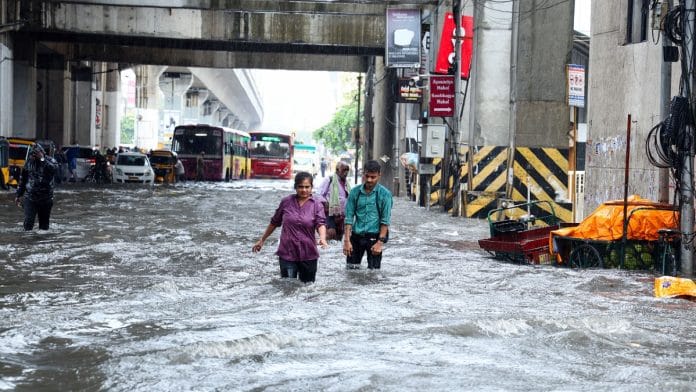Bengaluru: Red alert in Chennai and other parts of Tamil Nadu, and heavy rain in parts of Karnataka and Andhra Pradesh. The Northeast Monsoon has arrived with a bang, while the Southwest Monsoon has completely withdrawn.
Hundreds, if not thousands, remain stranded in major cities across these states as a result. None was spared by the rainwater, which entered the villa of actor Rajinikath in Chennai’s posh Poes Garden area, and inundated Bengaluru’s Manyata Tech Park—home to several Fortune 500 companies.
The IMD has predicted more intense rainfall for Tamil Nadu, Puducherry, and Karnataka over the next seven days. “For next two months we have forecasted above average rain at IMD,” said Dr Mrutyunjay Mohapatra, director general of meteorology at IMD, while adding that the date of onset is “normal”.
ThePrint explains what the Northeast Monsoon pattern over India is, and how this year compares to historic records.
Also Read: Gujarat flooded, eastern India parched & no ‘monsoon breaks’. IMD predictions hit the mark
What is Northeast Monsoon
India has two major monsoon seasons—the Southwest Monsoon which brings winds from the southwest direction towards the Himalayas, and the Northeast Monsoon where winds blow from the northeast towards the Indian Ocean. The former occurs in the summer months from June to September, when heat in the interior of the country creates low pressure, ushering winds in from the Indian Ocean.
The Northeast Monsoon, also known as the retreating monsoon, typically begins in October.
It brings cold and dry winds from the Himalayas towards the warmer Indian Ocean and Deccan Peninsula. These winds pick up moisture on their way down, dumping them over the southern regions of India.
How does onset date compare historically
Northeast Monsoon over India has a traditional onset date in mid-October. Since 1871, the onset date has always been on or after 15 October. The most delay was in 1951 when it began on 6 November.
Through 1871 to 2010, IMD’s data sets indicate that the mean onset date of Northeast Monsoon remains unchanged while withdrawal often extended from December to January.
“The rainfall for now is excess over Tamil Nadu, but if we look at the southeast peninsula as a whole it is normal,” said Dr Mohapatra.
Last year, the Northeast Monsoon began in southern India on 22 October, with both Thirunelveli as well as Thoothukudi in Tamil Nadu witnessing record-breaking rain that day. But the Northeast Monsoon continues to be erratic over the southern states, resulting in varying total volume of rainfall. While the last five years averaged 455 cm of rain over Tamil Nadu, for example, just 2021 saw over 710 cm of rain. In the preceding years of 2022 to 2019, the onset was on October 29, 26, 28, and 17th respectively.
What defines Northeast Monsoon
This season of monsoon is characterised by the winds from Himalayas towards the low pressure region in the south. According to IMD, this year’s onset was declared to be on 15 October due to a number of reasons.
First, a Well Marked Low Pressure Area lies over the central part of southern Bay of Bengal; second, easterly and northeasterly winds set in over southern peninsular India, south and adjoining central Bay of Bengal and extends up to middle tropospheric levels; and third, fairly widespread to widespread light to moderate rainfall occurred over southeast peninsula with isolated heavy to very heavy rainfall observed over Tamil Nadu and Puducherry, coastal Andhra Pradesh, Rayalaseema and Kerala.
What defines retreat of the monsoon
The rain moves gradually from the northern states closer to the Himalayas lower across the country, retreating away to the Indian Ocean in the process. The monsoons withdraw from the far northwestern parts of the country in September, from the peninsula by October, and from the southeastern end by December.
The process is gradual and takes a span of three months on average. The end of the monsoon is characterised by clear skies with no heavy rain, along with a drop in daytime temperatures.
Which states will receive rain during Northeast Monsoon
While the Southwest Monsoon enters the subcontinent through Kerala, the Northeast Monsoon retreats on the eastern side of the Western Ghats, adjoining the Bay of Bengal. Thus, the coastal states of Tamil Nadu, Puducherry, Andhra Pradesh and Telangana, Orissa, and to an extent, West Bengal will receive rain until the end of December.
Also Read: Above-normal rainfall, or is it? Why monsoon forecast remains a challenge for IMD







Your description of south west and north east monsoons is wrong
North east monsoons starts from Indian Ocean and monsoon sets from Kerala’s moving towards north eastern direction thereby covering Kerala Andhra Telangana Odisha central india and there on